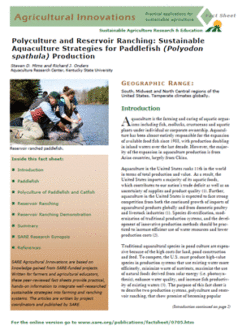Aquaculture is the farming and caring of aquatic organisms including fish, mollusks, crustaceans and aquatic plants under individual or corporate ownership. Aquaculture has been almost entirely responsible for the expansion of available food fish since 1988, with production doubling in inland waters over the last decade. However, the majority of the expansion in aquaculture production is from Asian countries, largely China.
Aquaculture in the United States ranks 11th in the world in terms of total production and value. As a result, the United States imports a majority of its aquatic foods, which contributes to our nation's trade deficit as well as an uncertainty of supplies and product quality. Further, aquaculture in the United States is expected to face strong competition from both the continued growth of imports of aquacultural products globally and from domestic poultry and livestock industries. Species diversification, modernization of traditional production systems, and the development of innovative production methods should be practiced to increase efficient use of water resources and lower production cost.
Traditional aquacultural species in pond culture are expensive because of the high costs for land, pond construction and feed. To compete, the U.S. must produce high-value species in production systems that use existing water more efficiently, minimize waste of nutrients, maximize the use of natural foods derived from solar energy (i.e. photosynthesis), enhance water quality, and increase fish productivity of existing waters. The purpose of this fact sheet is to describe two production systems, polyculture and reservoir ranching, that show promise of becoming popular methods for increasing fish production and profits in inland waters compared to a traditional monoculture system. We also examine the usefulness of paddlefish as a high-value, emerging species that grows well in polyculture with channel catfish or in reservoir ranching.
Geographic Adaptability: South, Midwest and North Central regions of the United States. Temperate climates globally.
Want more information? See the related SARE grant:
